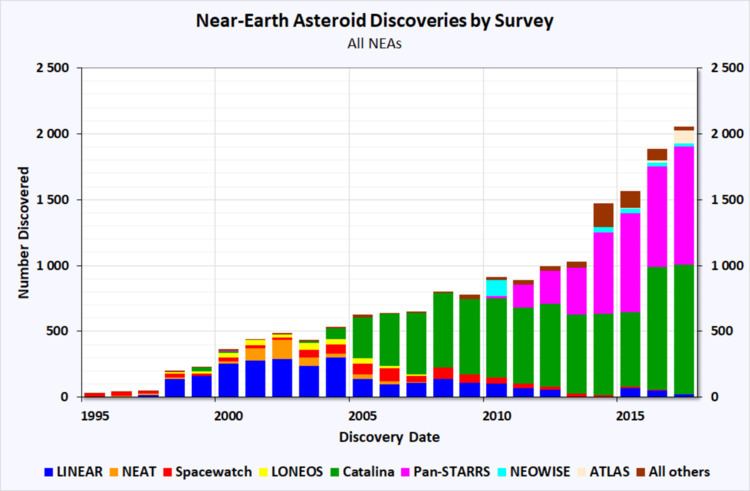Alternative names CSS Target near-Earth object | ||
 | ||
Website www.lpl.arizona.edu/css/ | ||
Catalina Sky Survey (CSS) is a project to discover comets and asteroids, and to search for near-Earth objects (NEOs). More specifically, CSS is to search for any potentially hazardous asteroids that may pose a threat of impact. Its southern hemisphere counterpart, the Siding Spring Survey (SSS) was closed in 2013 due to loss of funding.
Contents
Mission
The NEO Observations Program is a result of a United States 1998 congressional directive to NASA to begin a program to identify 1 kilometre (0.62 mile) or larger objects to around 90 percent confidence level or better. The Catalina Sky Survey, located at the Mount Lemmon Observatory in the Catalina Mountains north of Tucson, carries out searches for near-earth objects, NEOs, contributing to the Congressionally mandated goal.
In addition to identifying impact risks the project also obtains other scientific information, including: improving the known population distribution in the main belt, finding the cometary distribution at larger perihelion distances, determining the distribution of NEOs as a product of collisional history and transport to the inner Solar System, and identifying potential targets for flight projects.
Techniques
Catalina Sky Survey (CSS) utilized two US telescopes, a 1.5 meter (60 inch) f/2 telescope on the peak of Mt. Lemmon, and a 68 cm (27 inch) f/ 1.7 Schmidt telescope near Mt. Bigelow (both in the Tucson, Arizona area). The CSS southern hemisphere counterpart, the Siding Spring Survey (SSS), used a 0.5 meter (20 inch) f/3 Uppsala Schmidt telescope at Siding Spring Observatory in Australia. All sites use identical, thermo-electrically cooled cameras and common software that was written by the CSS team. The cameras are cooled to approximately −100 °C (−148 °F) so their dark current is about 1 electron per hour. These 4096×4096 pixel cameras provide a field of view of 1 degree square on with the 1.5-m telescope and nearly 9 square degrees with the Catalina Schmidt. Nominal exposures are 30 seconds and the 1.5-m can reach objects fainter than 21.5 V in that time.
CSS typically operates every clear night with the exception of a few nights centered on the full moon. The southern hemispheres' SSS in Australia ended in 2013 after funding was discontinued.
Discoveries
In 2005, CSS became the most prolific NEO survey surpassing Lincoln Near-Earth Asteroid Research (LINEAR) in total number of NEOs and potentially hazardous asteroids discovered each year since. CSS discovered 310 NEOs in 2005, 396 in 2006, 466 in 2007, and in 2008 564 NEOs were found.
List of discovered minor planets
For a complete listing of all minor planets discovered by the Catalina Sky Survey, see the index section in list of minor planets.
CSS/SSS team
The CSS team is headed by Eric Christensen of the Lunar and Planetary Laboratory of the University of Arizona.
The full CSS team is:
SSS
Educational outreach
The CSS has helped with Astronomy Camp showing campers how they detect NEOs. They even played a role in an astrophotography exercise with the 2006 Adult Astronomy Camp ending up with a picture that was featured on Astronomy Picture of the Day.
